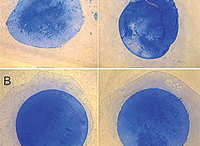A femtosecond laser can produce continuous anterior capsular incisions that are twice as strong, five times as precise in size and 12 times as precise in shape compared to manual capsulorhexis, according to a recent article in Science Translational Medicine.

Femtosecond laser capsular incisions (bottom) are nearly perfectly circular compared with manual incisions (top).
Using a laser-based system—which employed optical coherence tomography to pinpoint the laser—a clinical trial of 50 patients determined that the laser came much closer to the intended size of the capsular disc (within 25µm) than the manual procedure (within 305µm).
Also, using a scoring system that ranks a perfect circle as a 1.0, the researchers found that the laser incision scored about 0.95 compared with about 0.77 for the manual technique. This leads to better IOL centration and a tighter fit, reducing the chances of a lens shift and improving the alignment of the lens with the pupil. This is important for multifocal and accommodating lenses, which need to be precisely aligned to function well.
In addition, the laser method requires 40% less ultrasound energy to remove the lens. The researchers also found that the laser technique improved visual acuity more than the manual approach, but the difference was not statistically significant due to the small number of patients studied.
Palanker DV, Blumenkranz MS, Andersen D, et al. Femtosecond laser-assisted cataract surgery with integrated optical coherence tomography. Sci Transl Med. 2010 Nov 17;2(58):58ra85.

